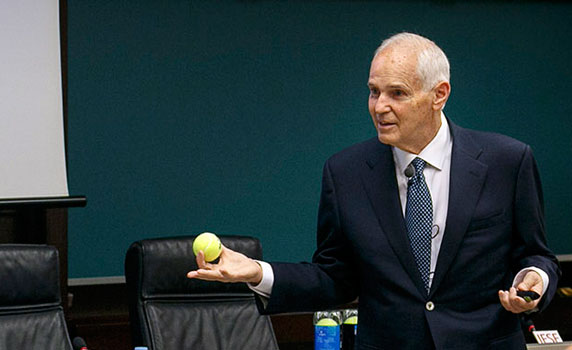
Is your "inner instructor" holding you back?
This was the question posed by best-selling author and coaching expert, Tim Gallwey, at IESE last week. Gallwey was special guest at a continuous education session for alumni, hosted by Professor Alberto Ribera. The session was focused on how to drive performance and productivity, drawing on ideas from Gallwey’s book, The Inner Game of Work. Published in 2009, the book sets out a number of coaching methods that have been adopted by Apple and IBM, among others, in their development programs.
Who’s in Charge Anyway?
Gallwey posed a series of questions about how we make decisions and take actions.
"Who is the ‘manager’ in your mind? And what is the relationship between your manager and the managed? Who is taking orders from whom?" he asked.
He drew attention to the phenomenon of self-interference: the dialog between our "inner instructor" and our "inner doer." According to Gallwey, when we listen to our critical and judgmental inner instructor we reduce our potential to perform. If we cannot do as this instructor asks, it provokes a downward spiral of self-criticism that creates a negative effect on our performance. He used a tennis analogy about ‘over-thinking’ physical movements to illustrate this point.
In a business environment, Gallwey likened this dialog to the process of a salesperson trying to make a sale without allowing the buyer enough space or time to express his or her needs. This may be the way the salesperson’s inner instructor thinks is best, and the buyer may allow the salesperson to "control" the conversation, he said; but the likelihood of a sale is "very low."
"In this case, your know-it-all inner instructor has interfered with performance."
Culture Versus Strategy
The audience was then asked to think about how a five year-old approaches washing a car. It’s fun – but if the child is paid 50 cents, fun becomes work. The enjoyment is modified by the expectation that the car will be cleaned to a parent’s satisfaction and standards. In other works, culture has taken over what was an enjoyable game.
"No matter how great your company’s strategy is, culture can get in the way of optimum performance," said Gallwey. There are three types of conversation that companies need to negotiate: background (cultural conversations), government (corporate conversations) and immediate (external conversations).
How can companies learn to tune into the right conversation? He recommended his STOP Tool (Step Back, Think, Organize Your Thoughts and Proceed) to regain focus on what is really important.
How Do We Really Learn?
Gallwey shared the example of someone he had coached – an overly aggressive manager called Joe. During their sessions, said Gallwey, he attempted to focus Joe’s attention on process, rather than results. For Joe, part of this meant observing the eye movement of his team members during meetings. Gallwey then got Joe to focus on the intonation of their voices. Without Joe receiving any more specific instructions on how to modify his own behavior, he instinctively began to do so – as a result of observing his team.
The conclusion? We don’t learn through instructions or advice. We learn through observation.
Beating the Monday Morning Blues
According to Gallwey, feeling fulfilled at work stems from the relationship between enjoyment, learning and performance. If enjoyment and learning increase, performance and productivity also increase.
As an example of how to "put a smile on the grim face of Monday morning workers," Gallwey recounted an example from his work with AT&T.
He showed operators there that they could increase the "warmth" of customers’ voices – even in calls lasting just a few seconds – just by modulating their own intonation. Learning and having a positive impact on the customers in turn had a positive impact on the operators’ enjoyment of their job. This led to an increase in performance and productivity.
Keys to a Goldmine
If CEOs can identify the obstacles that are interfering with their objectives, says Gallwey, they can unlock a "goldmine." By freeing themselves and their employees from the fear created by their inner instructors, they can give "freer rein to the potential of their inner doers. And move forward as a company."
 |